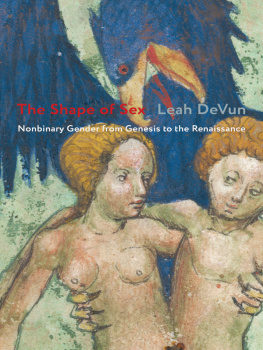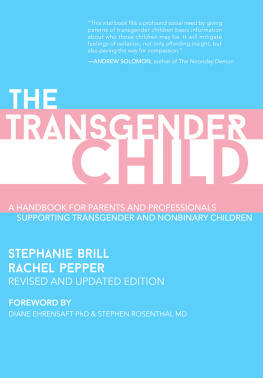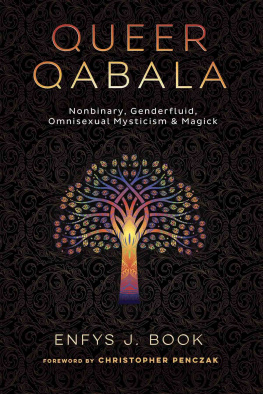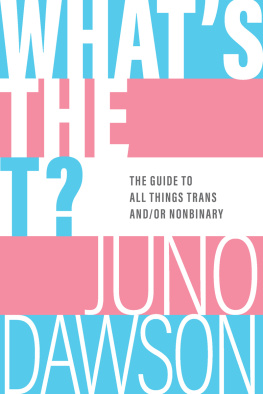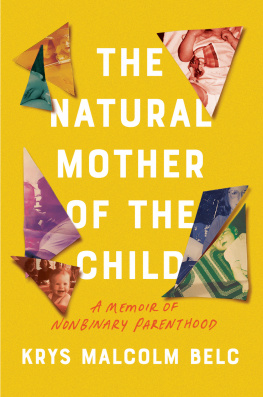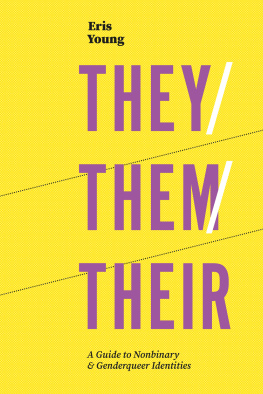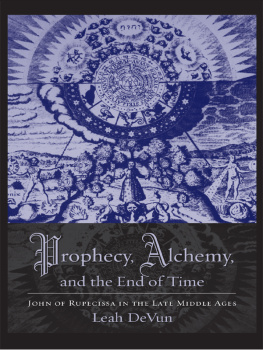Table of Contents
The Shape of Sex
The Shape of Sex
Nonbinary Gender
from Genesis to
the Renaissance
Leah DeVun
Columbia University Press
New York
Columbia University Press wishes to express its appreciation for assistance given by
the Rutgers University Research Council in the publication of this book.
Columbia University Press
Publishers Since 1893
New YorkChichester, West Sussex
cup.columbia.edu
Copyright 2021 Columbia University Press
All rights reserved
EISBN 978-0-231-55136-6
Library of Congress Cataloging-in-Publication Data
Names: DeVun, Leah, author.
Title: The shape of sex : nonbinary gender from genesis to the renaissance / Leah DeVun.
Description: New York : Columbia University Press, [2021] |
Includes bibliographical references and index.
Identifiers: LCCN 2020030685 (print) | LCCN 2020030686 (ebook) |
ISBN 9780231195508 (hardback) | ISBN 9780231195515 (trade paperback) |
ISBN 9780231551366 (ebook)
Subjects: LCSH: Intersex peopleEuropeHistory. | SexEuropeHistory. |
Gender nonconformityEuropeHistory.
Classification: LCC HQ78.2.E85 D49 2021 (print) | LCC HQ78.2.E85 (ebook) |
DDC 306.76/85094dc23
LC record available at https://lccn.loc.gov/2020030685
LC ebook record available at https://lccn.loc.gov/2020030686
A Columbia University Press E-book.
CUP would be pleased to hear about your reading experience with this e-book at .
Cover image: Alchemical hermaphrodite. Aurora consurgens.
Zrich, Zentralbibliothek
Zrich, MS Rh. 172, front paste-down.
Photo: www.e-codices.ch.
For Macauley
Contents
I couldnt write a book so concerned with the formation of the self in relation to a community without acknowledging my own community during these years of researching and writing. Ive been fortunate enough to work in the company of wonderful colleagues all over the country, and Ive benefited enormously from their teaching, scholarship, and companionship. Its a pleasure and a privilege to acknowledge in particular Rudy Bell, Alastair Bellany, Carlos Blanton, Daniel Bornstein, Walter Buenger, Lauren Clay, Anthony DiBattista, Carolyn Dinshaw, Mary Doyno, Ruth Evans, Paula Findlen, Marisa J. Fuentes, Jessica Goldberg, Karen Green, Monica H. Green, Leor Halevi, Anna Harrison, Sharon Holland, Tammy Ingram, Anna T. Jones, Jennifer Jones, Nick Jones, Katrina Karkazis, Samantha Kelly, Seth Koven, Greta LaFleur, Robert Lerner, Kathleen P. Long, Jim Masschaele, Lou Masur, Erica Milam, Pritipuspa Mishra, Robert Nye, Peggy McCracken, Robert Mills, Ramona Naddaff, Cary J. Nederman, Tara Nummedal, Robert A. Nye, Marcia Ochoa, Masha Raskolnikov, Steve Reinert, Elizabeth Reis, Matt Richardson, David Rollo, James Rosenheim, Mike Ryan, Johanna Schoen, Rebecca Schloss, Laura Smoller, Arlene Stein, Max Strassfeld, Susan Stryker, Paola Tartakoff, Marvin J. Taylor, Kyla Wazana Tompkins, Zeb Tortorici, Elly Truitt, and Laura Weigert for reading portions of this book, giving suggestions along the way, or encouraging my scholarly pursuits in general. I give special thanks to Katharine Park, Joan Cadden, Anna Kosowska, and Asa S. Mittman for their generosity in giving me extensive feedback on earlier versions of this book (all mistakes are, of course, my own). Id like to acknowledge all of my colleagues at both Texas A&M University and Rutgers University, and Im grateful to have been a part of both universities while I worked on this book. I also owe a debt to my labor union, the AAUP-AFT, and I wish to thank labor organizers and the labor movement in general, at Rutgers University and beyond.
Id also like to acknowledge the work of the late historian John Boswell, whose Christianity, Social Tolerance, and Homosexuality was recommended to me when I was still an undergraduate by my professor, Robert Stacey. That book has long been an important work for me, showing how premodern history can continue to matter and move us even centuries later. I was lucky enough to study with other inspiring professors at both the University of Washington and Columbia University, including Robin Chapman Stacey, Mary ONeil, R. Tracy McKenzie, Joel Kaye, Adam Kosto, and Robert Somerville, and I thank them for guiding me with their teaching and mentorship. Of all of my teachers over the years, I give special pride of place to Caroline Walker Bynum, a brilliant scholar who is also a generous teacher, tireless activist, and compassionate person. Shes been a model for me for more than two decades, and I acknowledge her here with much gratitude and admiration.
Many institutions provided me with space, financial support, and intellectual community, and I thank the American Philosophical Society, the Texas A&M University Melbern G. Glasscock Center for Humanities Research, the Huntington Library, UCLA David Geffen School of Medicine, UCLA Center for Medieval and Renaissance Studies, USC-Huntington Early Modern Studies Institute, University of Texas Medical Branch at Galveston, the Rutgers Institute for Research on Women, Rutgers Center for Historical Analysis, and Rutgers University Research Council and Office of Research and Economic Development for their generous support. I also thank especially the Institute for Research in the Humanities at the University of Wisconsin, Madison, where I began work on this book, and where I was lucky to meet Richard Avramenko, Jill Casid, A. Finn Enke, Judy Houck, Michael Jay McClure, Katja Vehlow, Michael Velliquette, and Tehshik Yoon. I also thank the Stanford Humanities Center, where I spent a year as a faculty fellow and was able to enjoy the productive company of other fellows and faculty members, especially Georgia Cowart, Paula Findlen, Peggy Phelan, Gayle Rubin, Londa Schiebinger, Namwali Serpell, Debora L. Silverman, and Marilyn Yalom. I would also like to thank my colleagues who invited me to present my work at their universities and institutes, including Alex Baldassano, Brad Bouley, Mara Bulln-Fernndez, Tina Chronopoulos, Sara Lipton, Glenn Burger, Steven F. Kruger, Chris Nygren, and Mary Fissell, who let me benefit from generative questions and helpful suggestions. I also thank my Rutgers University students, including my honors thesis students, and all of my graduate students, including Melissa Reynolds, Jesse Bayker, M. Dale Booth, Katy Gray, Hugo Marquez Soljancic, and Leo Valdes, and the new generation of emerging scholars at Rutgers and beyond, whove been pushing my thinking about gender, race, and sexuality, and who are the source of so many innovative and exciting ideas right now.
I give special thanks to the staffs of the libraries and archives that I visited, and Id like to single out the staff at the New York Academy of Medicine for their helpfulness, as well as Rutgers Universitys Jim Niessen and Tom Glynn. I also thank Susan LEngle, who sent me scans of an obscure manuscript from SLUs Knights of Columbus Vatican Library when I was in dire need. I thank Katie Jasper Benevento for assistance with my manuscripts and M. Dale Booth for help in securing permissions for the images published here.
I owe a huge debt to my parents, Gail and Esmond DeVun, whove given me endless love, support, and encouragement, and I give special acknowledgement to my late grandmother and great-grandmother, Lorraine Veazey and Therese Hebert, brilliant and creative women whose upbringing in rural Louisiana meant thatalthough their lives were long and richthey were never able to realize the full promise of their talents. I continue to benefit from the support of my other family members, and I thank them here, especially Estelle DeVun, Stephanie Patton, Lauren DeVun Flanagan, Lindsay DeVun Pfefferle, Drew DeVun, Kendra Donald, and the Donald family. I thank my other ancestors too, both known and unknown. I also gratefully acknowledge the support of Katie Anania, Gwendolyn Beetham, Jess Bennett, Rebecca Bloom, Dante Brebner, Andy Campbell, Laura Campagna, Jasmine Cassata, Cassils, Liz Collins, Lainie Cosgrove, J Dellecave, Frank Discussion, Christine Doza, Jen and Tony Elias, Elena Favela, Aaron Flynn, Meghan Flynn, Jodi Frizzell, Greg Garry, Tamara Gayer, Erin Gentry, Aisling Hamrogue, Clarity Haynes, Karen Heagle, Kadin Henningsen, Riitta Ikonen, Liz Insogna, Tyler Lafreniere, Octavia Kohner, Isabelle Lumpkin, Sara Marcus, Derek Marks, Robert Marshall, Lynn McCabe, Tey Meadow, Bibiana Skraby Medkova, Andrea Merks, R.J. Messineo, Cristy Michel, K. Naca, Philip Nickel, Amanda Noa, M. Plaut, Shannon OMalley, Janet Phelps, Kristin Poor, Laine Rettmer, L. J. Roberts, Nina Rubin, Nicole Russell, Sara Maria Salamone, John M. Sapp, Beth Schindler, Roy Scranton, Purvi Shah, Manjari Sharma, Bree Sharp, Lauryn Siegel, Elizabeth Steeby, Julia Steinmetz, Sarah Sudhoff, Gregg Sundin, Astria Suparak, Caitlin Rose Sweet, Anna Thomas, Vicky Tamaru, Jeanne Vaccaro, Wendy Vogel, Tobaron Waxman, Laura Leigh Williams, MW Wilson, and Megan Wright.

